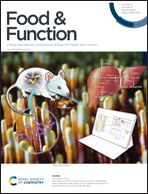An overview and update on the epidemiology of flavonoid intake and cardiovascular disease risk
Abstract
There is an accumulating body of literature reporting on dietary flavonoid intake and the risk of cardiovascular disease (CVD) in prospective cohort studies. This makes apparent the need for an overview and update on the current state of the science. To date, at least 27 prospective cohorts (in 44 publications) have evaluated the association between estimated habitual flavonoid intake and CVD risk. At this time, the totality of evidence suggests long-term consumption of flavonoid-rich foods may be associated with a lower risk of fatal and non-fatal ischemic heart disease (IHD), cerebrovascular disease, and total CVD; disease outcomes which are principally, though not exclusively, composed of cases of atherosclerotic CVD (ASCVD). To date, few studies have investigated outcome specific ASCVD, such as peripheral artery disease (PAD) or ischemic stroke. Of the flavonoid subclasses investigated, evidence more often implicates diets rich in anthocyanins, flavan-3-ols, and flavonols in lowering the risk of CVD. Although inferences are restricted by confounding and other inherent limitations of observational studies, causality appears possible based on biological plausibility, temporality, and the relative consistency of the reported associations. However, whether the associations observed represent a benefit of the isolated bioactives per se, or are a signal of the bioactives acting in concert with the co-occurring nutrient matrix within flavonoid-bearing foods, are issues of consideration. Thus, the simple interpretation, and the one most relevant for dietary advice, is that consumption of flavonoid-rich foods or diets higher in flavonoids, appear nutritionally beneficial in the prevention of CVD.

- This article is part of the themed collections: Recent Review Articles, Food & Function Recent HOT articles and International Conference on Polyphenols and Health (ICPH2019) collection


 Please wait while we load your content...
Please wait while we load your content...